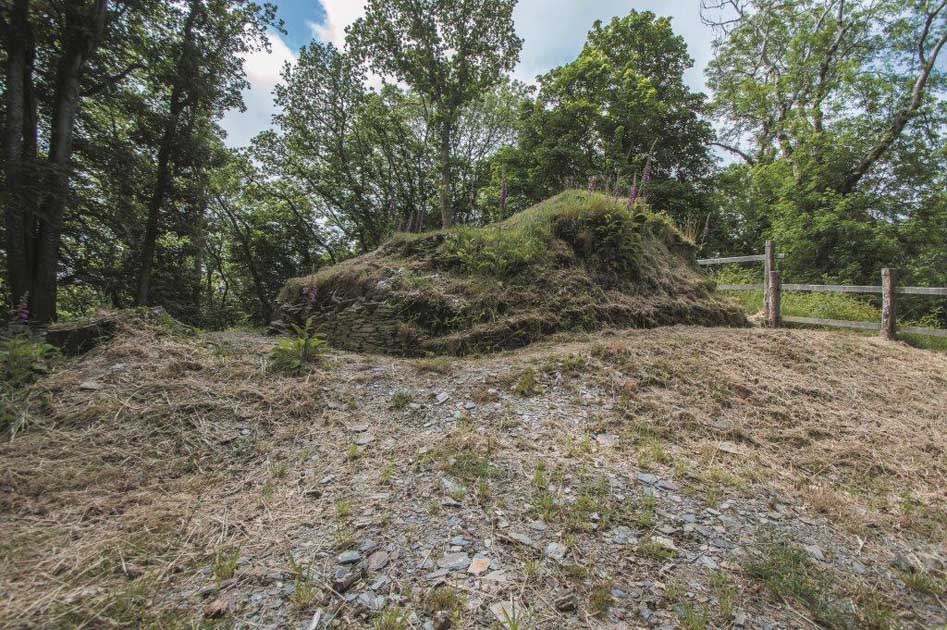Nevern Castle

Nevern Castle Details
Nevern Castle, remains of motte & bailey castle rebuilt in stone; also tower with rock cut ditch
- Closest To: Nevern, Newport
- Access: Free Public Access
- Grid Reference: SN082402
Nevern Castle is a complex but short-lived castle that survives as earthworks and low footings on a sloping outcrop of rock which overlooks the village of Nevern and the valley of the Afon Nevern. To east and west the outcrop drops steeply to tributary valleys, and the drop is equally steep to the south where the village is.
The site is bounded by an L-shaped ditch within which is a raised platform and upcast bank; on the north-western angle is a large motte upon which are the remnants of a round keep. A second ditch extends to the east of the motte within the platform. The natural slopes of the outcrop lie to south and east, creating a roughly triangular enclosure, and at the north-eastern corner is a substantial rock-cut ditch isolating a small area upon which are the foundations of a rectangular building. The whole site is open to the public at all times without charge, although parking is limited. Extensive archaeology has revealed much of the development of the site.
The earliest phase of occupation involved the construction of the ditch with a defensive bank, although the scale was relatively small, in about 1108 by Robert fitzMartin, who had been granted the right to conquer and hold lands of Cemais by King Henry I. Subsequently the motte was added and a small tower constructed on the top. A few years later, c1116, a new ditch and bank was constructed on a larger scale; to the west this enlarged the existing earthwork whilst to the north it was constructed outside the earlier work. In addition the eastern side of the enclosure was isolated with the construction of a ditch and bank, permitting the establishment of a small settlement. There were two entrances to the complex, both on the south side along the steep slope. At this time the whole complex was defended with timber structures. Probably during the Anarchy period in England, some of these defences were replaced in stone, the round tower erected on the motte, and the “settlement ditch” demolished. A great hall was built in the bailey, and a chapel. This foundation was the work of the Lord Rhys ap Gruffudd, who had established a hegemony over Cemais, at the cost of the fitzMartins.
Subsequent to this, the castle was strengthened by the addition of a curtain wall along the southern side, the hall was rebuilt and extended, and the Inner Ward of the castle was created at the eastern tip of the site with the rectangular building and an enclosure wall built from materials excavated from the ditch – it is likely this also furnished material for the southern wall. This inner area was accessed via a timber bridge. All were placed to be visible from the valley below indicating a desire to demonstrate visibly the power and wealth of the lord – and it seems certain this lord was Rhys ap Gruffudd. In 1158 the castle was returned to King Henry II, but Rhys was unhappy with his treatment by the new king, and recaptured the castle soon afterwards, perhaps damaging it in the process. Certainly in this period the south curtain wall was destroyed, and access at the south-west corner was instead protected by a pair of towers forming a gatehouse complex. Towards the end of the 12th century and still within the time of Rhys ap Gruffudd, the castle was strengthened again with the addition of a stone wall atop the bank connecting the southern gatehouse to the round keep, and another wall terminating in a square tower along the north side. However the construction style is different to the earlier masonry and probably reflects the return of the fitzMartins in the 1170s. A final phase of development – which may not have been completed, was the construction of a square tower in the Inner Ward from materials during the enlargement of the rock-cut ditch. In 1191 Rhys ap Gruffudd recaptured the castle, but a rebellion of his sons caused him to be imprisoned in the round tower, and in 1195 the whole site was destroyed by Hywel ap Rhys and his followers, with the buildings burned and walls cast down. The castle was never used as such again.
Nevern Castle official website
Become a supporter of my work to access a more detailed history